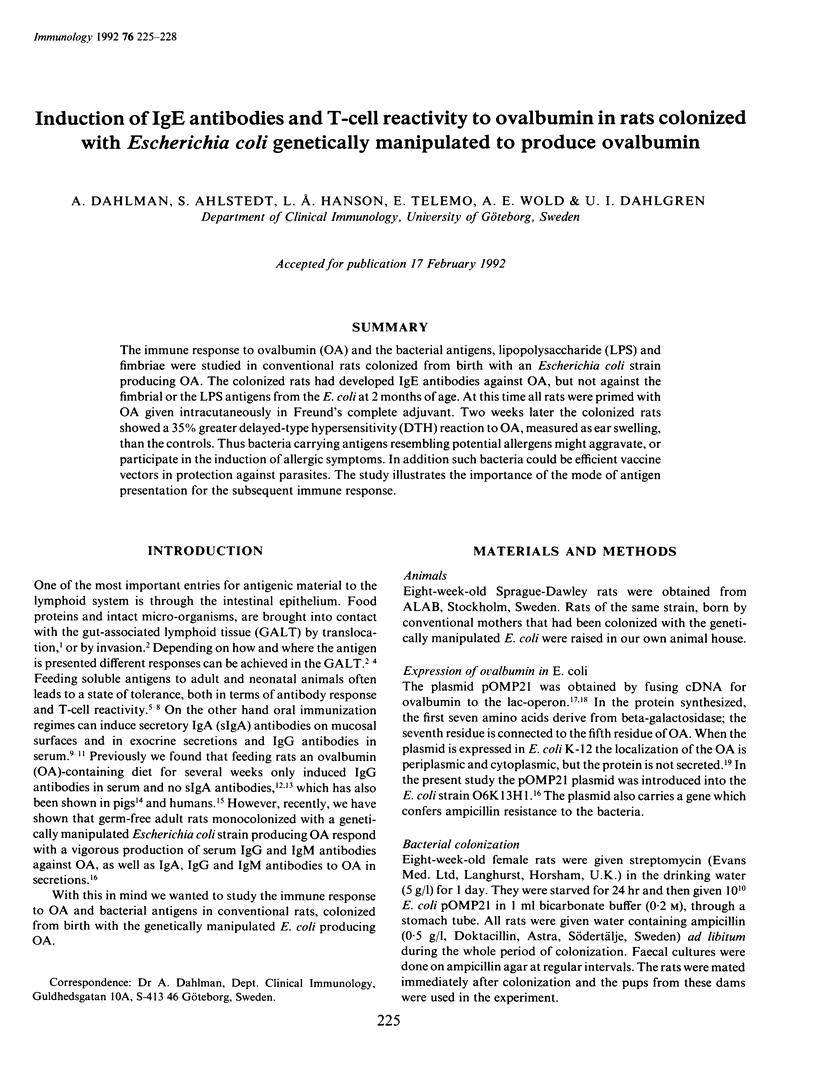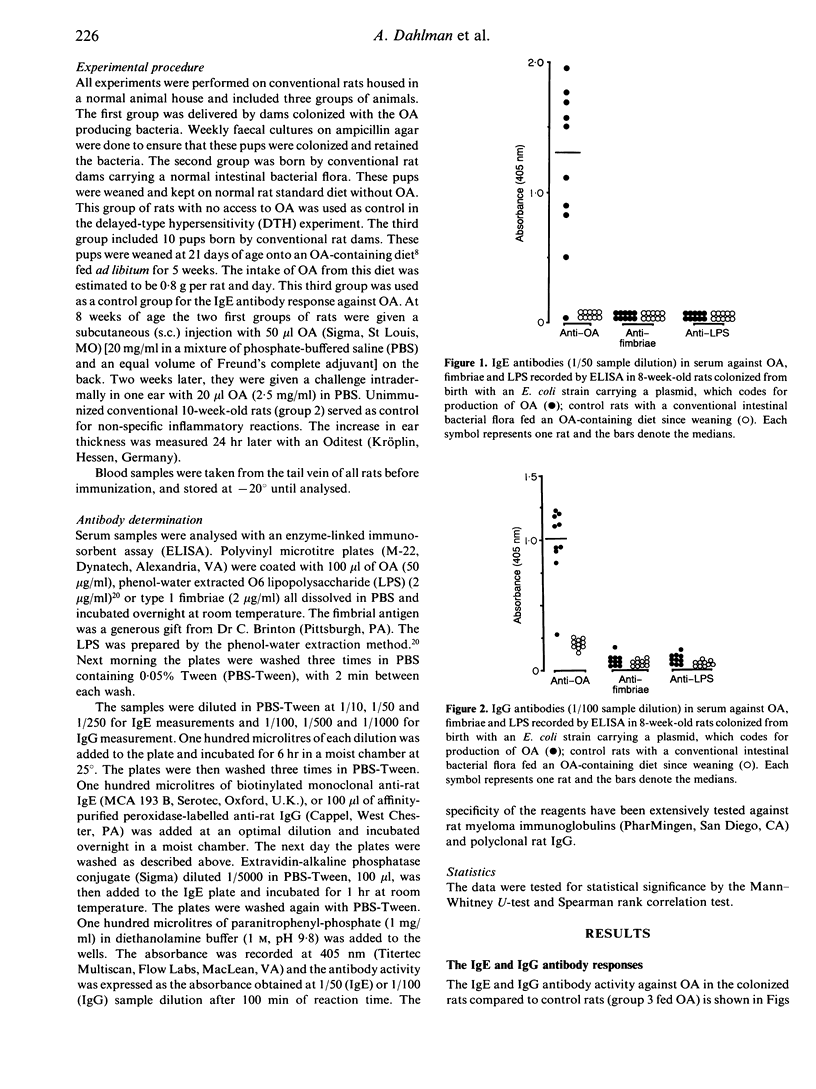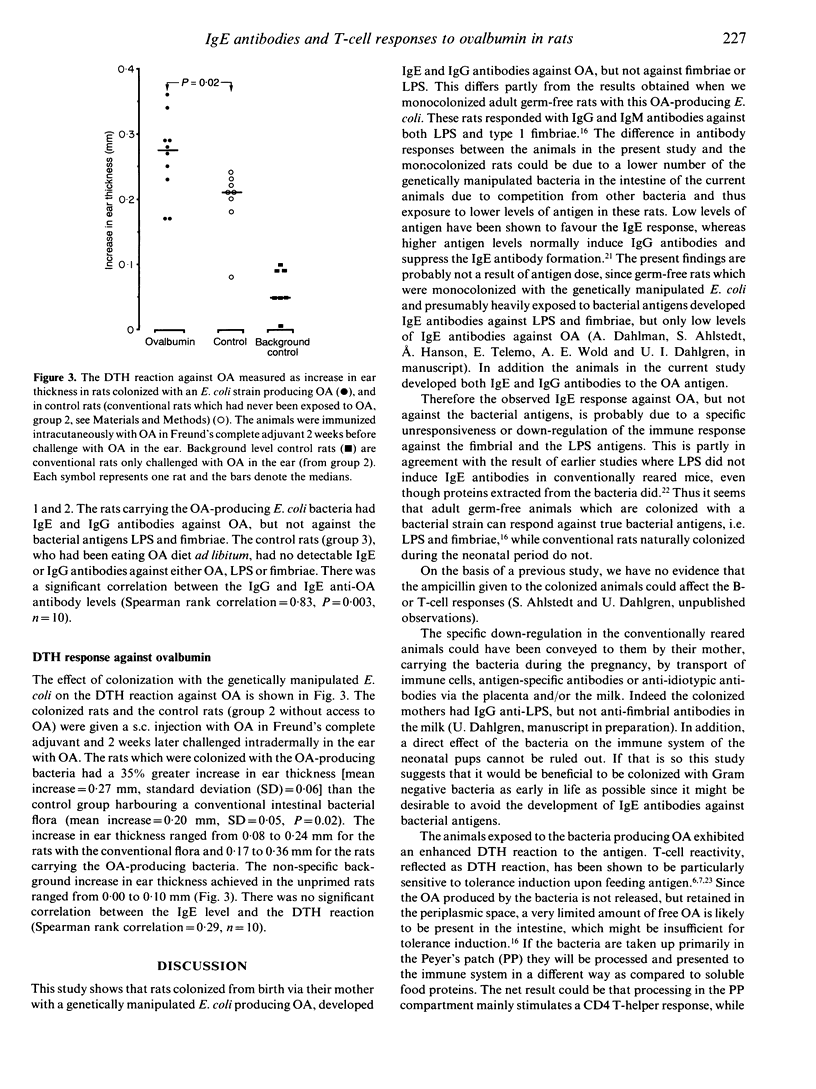Abstract
The immune response to ovalbumin (OA) and the bacterial antigens, lipopolysaccharide (LPS) and fimbriae were studied in conventional rats colonized from birth with an Escherichia coli strain producing OA. The colonized rats had developed IgE antibodies against OA, but not against the fimbrial or the LPS antigens from the E. coli at 2 months of age. At this time all rats were primed with OA given intracutaneously in Freund's complete adjuvant. Two weeks later the colonized rats showed a 35% greater delayed-type hypersensitivity (DTH) reaction to OA, measured as ear swelling, than the controls. Thus bacteria carrying antigens resembling potential allergens might aggravate, or participate in the induction of allergic symptoms. In addition such bacteria could be efficient vaccine vectors in protection against parasites. The study illustrates the importance of the mode of antigen presentation for the subsequent immune response.
Full text
PDF



Selected References
These references are in PubMed. This may not be the complete list of references from this article.
- Ahlstedt S., Björkstén B. Specific antibody responses in rats and mice after daily immunization without adjuvant. Int Arch Allergy Appl Immunol. 1983;71(4):293–299. doi: 10.1159/000233410. [DOI] [PubMed] [Google Scholar]
- Baty D., Mercereau-Puijalon O., Perrin D., Kourilsky P., Lazdunski C. Secretion into the bacterial periplasmic space of chicken ovalbumin synthesized in Escherichia coli. Gene. 1981 Dec;16(1-3):79–87. doi: 10.1016/0378-1119(81)90063-9. [DOI] [PubMed] [Google Scholar]
- Bland P. W., Warren L. G. Antigen presentation by epithelial cells of the rat small intestine. II. Selective induction of suppressor T cells. Immunology. 1986 May;58(1):9–14. [PMC free article] [PubMed] [Google Scholar]
- Brandtzaeg P., Halstensen T. S., Kett K., Krajci P., Kvale D., Rognum T. O., Scott H., Sollid L. M. Immunobiology and immunopathology of human gut mucosa: humoral immunity and intraepithelial lymphocytes. Gastroenterology. 1989 Dec;97(6):1562–1584. doi: 10.1016/0016-5085(89)90406-x. [DOI] [PubMed] [Google Scholar]
- Dahlgren U. I., Wold A. E., Hanson L. A., Midtvedt T. Expression of a dietary protein in E. coli renders it strongly antigenic to gut lymphoid tissue. Immunology. 1991 Aug;73(4):394–397. [PMC free article] [PubMed] [Google Scholar]
- Danneman P. J., Michael J. G. Reaginic antibody production to protein antigens of Escherichia coli and Pseudomonas aeruginosa by mice. Infect Immun. 1976 Sep;14(3):694–702. doi: 10.1128/iai.14.3.694-702.1976. [DOI] [PMC free article] [PubMed] [Google Scholar]
- Fubara E. S., Freter R. Source and protective function of coproantibodies in intestinal disease. Am J Clin Nutr. 1972 Dec;25(12):1357–1363. doi: 10.1093/ajcn/25.12.1357. [DOI] [PubMed] [Google Scholar]
- Goldblum R. M., Ahlstedt S., Carlsson B., Hanson L. A., Jodal U., Lidin-Janson G., Sohl-Akerlund A. Antibody-forming cells in human colostrum after oral immunisation. Nature. 1975 Oct 30;257(5529):797–798. doi: 10.1038/257797a0. [DOI] [PubMed] [Google Scholar]
- Greene M. I., Sugimoto M., Benacerraf B. Mechanisms of regulation of cell-mediated immune responses. I. Effect of the route of immunization with TNP-coupled syngeneic cells on the induction and suppression of contact sensitivity to picryl chloride. J Immunol. 1978 May;120(5):1604–1611. [PubMed] [Google Scholar]
- Hohmann A., Schmidt G., Rowley D. Intestinal and serum antibody responses in mice after oral immunization with Salmonella, Escherichia coli, and Salmonella-Escherichia coli hybrid strains. Infect Immun. 1979 Jul;25(1):27–33. doi: 10.1128/iai.25.1.27-33.1979. [DOI] [PMC free article] [PubMed] [Google Scholar]
- Husby S., Jensenius J. C., Svehag S. E. Passage of undegraded dietary antigen into the blood of healthy adults. Further characterization of the kinetics of uptake and the size distribution of the antigen. Scand J Immunol. 1986 Oct;24(4):447–455. doi: 10.1111/j.1365-3083.1986.tb02133.x. [DOI] [PubMed] [Google Scholar]
- Mercereau-Puijalon O., Kourilsky P. Introns in the chicken ovalbumin gene prevent ovalbumin synthesis in E. coli K12. Nature. 1979 Jun 14;279(5714):647–649. doi: 10.1038/279647a0. [DOI] [PubMed] [Google Scholar]
- Mercereau-Puijalon O., Royal A., Cami B., Garapin A., Krust A., Gannon F., Kourilsky P. Synthesis of an ovalbumin-like protein by Escherichia coli K12 harbouring a recombinant plasmid. Nature. 1978 Oct 12;275(5680):505–510. doi: 10.1038/275505a0. [DOI] [PubMed] [Google Scholar]
- Mestecky J., McGhee J. R., Arnold R. R., Michalek S. M., Prince S. J., Babb J. L. Selective induction of an immune response in human external secretions by ingestion of bacterial antigen. J Clin Invest. 1978 Mar;61(3):731–737. doi: 10.1172/JCI108986. [DOI] [PMC free article] [PubMed] [Google Scholar]
- Pierce N. F., Kaper J. B., Mekalanos J. J., Cray W. C., Jr, Richardson K. Determinants of the immunogenicity of live virulent and mutant Vibrio cholerae O1 in rabbit intestine. Infect Immun. 1987 Feb;55(2):477–481. doi: 10.1128/iai.55.2.477-481.1987. [DOI] [PMC free article] [PubMed] [Google Scholar]
- Telemo E., Bailey M., Miller B. G., Stokes C. R., Bourne F. J. Dietary antigen handling by mother and offspring. Scand J Immunol. 1991 Dec;34(6):689–696. doi: 10.1111/j.1365-3083.1991.tb01593.x. [DOI] [PubMed] [Google Scholar]
- Vaz N. M., Maia L. C., Hanson D. G., Lynch J. M. Inhibition of homocytotropic antibody responses in adult inbred mice by previous feeding of the specific antigen. J Allergy Clin Immunol. 1977 Aug;60(2):110–115. doi: 10.1016/0091-6749(77)90035-5. [DOI] [PubMed] [Google Scholar]
- Wold A. E., Dahlgren U. I., Ahlstedt S., Hanson L. A. Lack of IgA antibody response in secretions of rat dams during long-term ovalbumin feeding. Induction of systemic tolerance in pups but not in adult rats. Int Arch Allergy Appl Immunol. 1987;84(4):332–338. doi: 10.1159/000234446. [DOI] [PubMed] [Google Scholar]
- Wold A. E., Dahlgren U. I., Ahlstedt S., Hanson L. A. Rats are sensitive to induction of tolerance by feeding only at young age. Monogr Allergy. 1988;24:251–252. [PubMed] [Google Scholar]
- Wold A. E., Dahlgren U. I., Hanson L. A., Mattsby-Baltzer I., Midvetdt T. Difference between bacterial and food antigens in mucosal immunogenicity. Infect Immun. 1989 Sep;57(9):2666–2673. doi: 10.1128/iai.57.9.2666-2673.1989. [DOI] [PMC free article] [PubMed] [Google Scholar]


